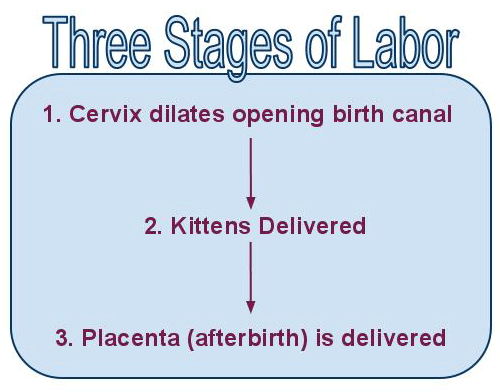
Photo by Melanie Cook (Flickr)
I am pleased to say that I have a video of a cat giving birth. It happens to be a wildcat, a serval called "Dea" and she gives birth to three kittens at the A1 Savannahs cattery/farm. I made the video with material provided by Kathrin Stucki of A1 Savannahs. Thank you Kathrin.
A serval may not demonstrate the exact same behaviour as described below because she is a wildcat but the principles are the same, of course. I have decided, therefore to present that video here and add a some details taken from the much respected, Cat Owner's Home Veterinary Handbook, Fully Revised and Updated. But first a little diagram showing the three stages of labor.

1. The first stage: - this may last 12 hours plus. It begins with the mother panting with purring which might increase towards the moment of birth. The mother becomes more active and moves around. She may turn (and/or snap) to her rear and strain. She may pant and the uterus contracts. This is noticeable in the video. The body moves when a contraction takes place and the straining tells on Dea's face.
With the onset of labor the uterine horn contracts. This pushes the kitten "down into the central cavity"1. The cervix dilates because of the pressure against it. The kitten then slides into the vagina on maximum dilation. If the water bag surrounding the kitten ruptures before birth it passes out and in less than 30 minutes the kitten follows and is born. Most often the kitten comes out head first - the "diving" position.
2. Kittens Delivered: - At the moment of birth you can see Dea lick her kitten and she removes the foetal membrane (the rough tongue achieves this). The umbilical cord is severed. The mother continues to lick the kitten clearing the nose and mouth to aid breathing.
3. Afterbirth Delivered: - A placenta follows after the kitten. You can see Dea eating the placenta. It is thought that this instinctive behaviour is to remove evidence of birth as a protective measure. This many not happen, however. A placenta that is not delivered can "cause a serious postnatal infection"1.
When born the kittens are drawn to their mother's nipples for feeding, their sucking helps bring on the production of mother's milk (colostrum). Colostrum is high in mother's antibodies. The total elapsed time might be 2-6 hours. A mother can go into labor, out of labor and return to labor, extending the entire process by up to about 24 hours.
What we can do:
- A large kitten may get stuck at the vaginal opening. This can usually be sorted out by lubricating the birth canal with K-Y Jelly. For more difficult cases where assisting birth is required I would advise that you read the book, which is linked to above.
- Default position: do nothing and leave mother alone.
- Remove some or all of the placenta from the nest.
- May need to clamp the severed cord and tie it off and disinfect the stump - antiseptic or iodine.
- Remove the amniotic sac if the mother fails to do so to allow the kitten to breath.
Note:
1. Cat Owner's Home Veterinary Handbook by Drs Carlson and Giffin page 305.
Associated Pages:
![]()

